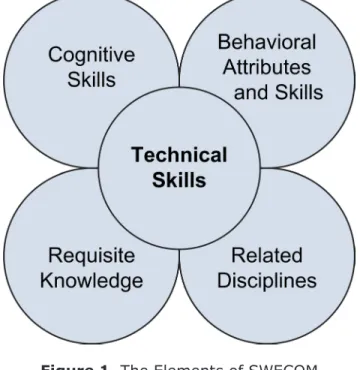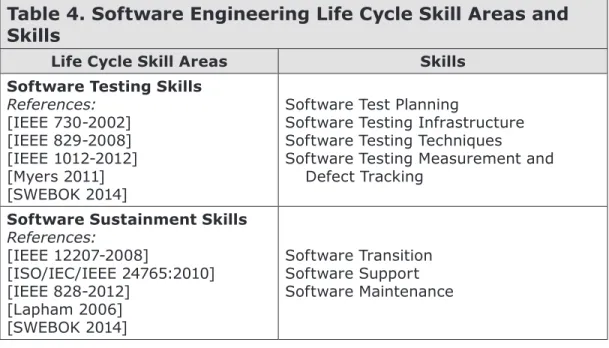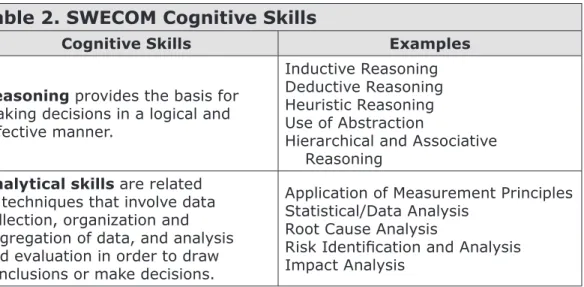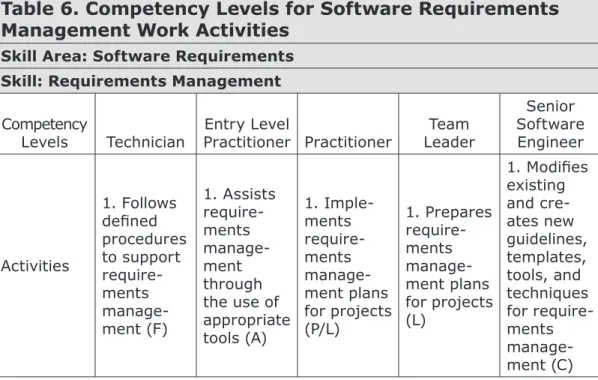The world-renowned IEEE Computer Society publishes, promotes and distributes a wide variety of authoritative computer science and engineering journals, journals, conference proceedings and vocational education products. The SWECOM worksheets Staffing Gap Analysis and Individual Gap Analysis are included in an appendix. A person who develops or maintains software can use this competency model to assess his or her current competency levels for various software engineering activities or to develop a plan for improving his or her competencies (such as requirements creation, design synthesis, software construction, test planning).
A manager (project, functional or line) could use this competency model to take stock of staff capabilities and identify areas for needed additions and improvements. In addition, a manager can use this model to advise individual employees, or HR staff can use the model to identify necessary training and recruitment activities. Skill domains in this competency model include skills that are broken down into activities rather than job roles because job roles typically depend on the organizational environment in which work activities are performed.
The activities in this model can be grouped into work roles by organizations, organizational units or projects to satisfy their needs. This competency model contributes to the growing body of knowledge that characterizes the software engineering profession and software engineering professional characteristics.
As indicated in Table 1, knowledge, behavioral characteristics and skills, and cognitive skills in SWECOM are the counterparts of personal effectiveness, academic competencies, and workplace competencies in the SU IT competency model. Competency levels for cognitive skills are not included in SWECOM, but cognitive skills become increasingly important at higher levels of technical competence because the scope and complexity of work activities increase and expand as the levels of competence and related work assignments increase. Furthermore, the list in Table 2 is intended to be illustrative—not exhaustive—of cognitive skills for software engineers.
Citations that provide the basis for and details of these cognitive skills are listed in the reference section of this document. Behavioral attributes and skills are expressed in the ability to productively apply knowledge, cognitive skills, and technical skills; they are not unique to software engineering, but enable software engineers to contribute effectively to desired outcomes. Some key behavioral traits and skills for software engineers are listed in Table 3; other behavior attributes and skills can be added.
Behavioral attributes and skills apply to all elements and at all levels of technical skill areas, skills and activities. Behavioral attributes and skills and cognitive abilities are not specified by the level of competence; however, increasing competence in cognitive skills and behavioral attributes and skills becomes more important as levels of technical competence, scope of responsibilities, and breadth of interactions increase.

SWECOM TECHNICAL SKILLS
Software engineers skilled in one or more lifecycle skill areas typically have some working knowledge of cross-cutting skill areas. SWECOM's five lifecycle skill areas and eight overarching skill areas are listed in Tables 4 and 5, respectively. SWECOM does not address competence in using tools or adherence to prescribed standards to perform activities, as these are specifically for organizations and projects. skills), skills within skill areas (for example, querying software requirements), and activities within skills (for example, prototyping to generate requirements).
An individual who is competent at the technician level to perform activities in one or more skills or skill areas may have advanced education (for example, a two-year US associate's degree or equivalent), one or more certificates industrial and any number - many years of experience. An individual who is competent as an entry-level practitioner to perform activities in one or more skills or skill areas is likely to have the necessary knowledge equivalent2 to that provided by a. An individual who is competent as a Technical Lead for one or more SWECOM activities, skills or skill areas is likely to have relevant knowledge and experience equal to or greater than that of a practitioner plus the behavioral attributes and skills of necessary to be effective. Technical Director.
The SWECOM activities, skills and skill areas are presented as a framework that can be adapted to suit the needs of individual organisations, programs and projects. For example, an Entry Level Practitioner may be competent to perform traceability analysis (P), or a Practitioner may be competent to lead certain activities (L).

SWECOM VALIDATION
The first spreadsheet (SWE-COM Staffing Gap Analysis Worksheet) is for use by managers, human resources professionals and others who analyze available and needed skills within an organizational unit. The second spreadsheet (SWECOM Individual Gap Analysis) is for use by an individual who wants to assess his or her levels of competence for different skills and activities at different levels of competence. An individual can use the spreadsheet for self-assessment or an individual and manager can use it as a basis for developing a plan of improvement for the individual; the improvement plan may include future assignments, mentoring and/or additional education and training.
As a result of the last observation, the developers of SWECOM added the behavioral attribute "cultural sensitivity". However, none of the interviewees who used other competency models had ever used the technician level or equivalent. Some interviewees expressed the opinion that there should not be a degree or minimum years of experience set as competency levels.
These six interviews did not provide a statistically significant sample of opinions, but they did show that SWECOM's effort is well conceived. The following sections of this document specify the life cycle and cross-cutting skill areas plus the skills and activities at different competency levels within each skill area.
Assists in the application of enablement techniques in the design of software components and modules. It helps to apply a specific software design strategy and methodology to create a software design (such as an incremental object-oriented approach). It helps to install tools and repositories for version control and configuration management.
Assists in installing tools and infrastructure for testing security requirements.

